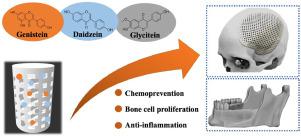Acta Biomaterialia ( IF 9.4 ) Pub Date : 2020-07-08 , DOI: 10.1016/j.actbio.2020.07.006 Naboneeta Sarkar 1 , Susmita Bose 1

|
Recent challenges in post-surgical bone tumor management have elucidated the need for a multifunctional scaffold, which can be used for residual tumor-cell suppression, defect repair, and simultaneous bone regeneration. In this perspective, 3D printing allows to create a wide variety of patient-specific implant with complex porous architecture and compatible mechanical strength to that of cancellous bone. Here, a multifunctional bone graft substitute is designed by incorporating the three primary soy isoflavones: genistein, daidzein, and glycitein onto a 3D printed (3DP) tricalcium phosphate (TCP) scaffolds with designed pores, endowing them with in vitro chemopreventive, bone-cell proliferating and immune-modulatory potential. The interconnected porosity and biodegradability of 3DP TCP ceramics have allowed controlled release kinetics of genistein, daidzein and glycitein in acidic and physiological buffer medium for 16 days, which is fitted with Korsmeyer-Peppas model. Presence of genistein, a well-known natural biomolecule shows a 90% reduction in vitro osteosarcoma (MG-63) cell viability and proliferation after 11 days. Meanwhile, daidzein, the other primary isoflavone, promotes in vitro cellular attachment and enhances viability and proliferation of human fetal osteoblast cell (hFOB). Furthermore, controlled release of genistein, daidzein, and glycitein from 3DP TCP scaffold demonstrates improved hFOB cell proliferation, viability, and differentiation in a dynamic flow-perfusion bioreactor, which is utilized to better simulate the clinical microenvironment. Finally, in vivo H&E staining confirms controlled co-delivery of genistein-daidzein-glycitein from 3DP scaffold carefully modulated neutrophil recruitment to the surgery site after 24 h of implantation in a rat distal femur model. These results advance our understanding towards multipronged therapeutic approaches utilizing synthetic bone graft substitutes as a drug delivery vehicle, and more importantly, demonstrate the feasibility of localized tumor cell suppression and bone cell proliferation for post-surgical defect repair application.
Statement of Significance
Designed multimodal porosity of 3D printed TCP scaffold allows a controlled and sustained release of soy isoflavones, genistein, daidzein and glycitein in both physiological and acidic pH. Presence of genistein shows 90% reduction in vitro bone cancer cell viability and proliferation. Meanwhile, controlled release of genistein, daidzein, and glycitein from 3DP TCP scaffolds demonstrate improved osteoblast cell proliferation, viability, and differentiation in static and dynamic flow-perfusion bioreactor. Furthermore, H&E staining at 24 h post-surgical specimens from rat distal femur model shows neutrophil recruitment at the surgery site is significantly decreased, suggesting the anti-inflammatory property of soy isoflavones. This work provides deeper understanding on the design of a multifunctional 3D printed patient-specific scaffold with enhanced in vitro chemopreventive, osteogenic and in vivo anti-inflammatory ability.
中文翻译:

从多功能 3D 打印骨组织工程支架中受控释放大豆异黄酮。
最近在手术后骨肿瘤管理方面的挑战阐明了对多功能支架的需求,该支架可用于残留肿瘤细胞抑制、缺损修复和同步骨再生。从这个角度来看,3D 打印允许创建各种特定于患者的植入物,这些植入物具有复杂的多孔结构和与松质骨兼容的机械强度。在这里,通过将三种主要大豆异黄酮:染料木黄酮、黄豆苷元和黄豆黄素结合到具有设计孔的 3D 打印 (3DP) 磷酸三钙 (TCP) 支架上,设计了一种多功能骨移植替代品,赋予它们体外化学预防、骨细胞增殖和免疫调节潜力。3DP TCP 陶瓷的相互关联的孔隙率和生物降解性允许染料木黄酮、黄豆苷元和黄豆黄素在酸性和生理缓冲介质中的受控释放动力学达 16 天,这符合 Korsmeyer-Peppas 模型。染料木黄酮是一种众所周知的天然生物分子,在 11 天后,体外骨肉瘤 (MG-63) 细胞活力和增殖降低了 90% 。同时,另一种主要异黄酮黄豆苷元在体外促进细胞附着并增强人胎儿成骨细胞 (hFOB) 的活力和增殖。此外,来自 3DP TCP 支架的染料木黄酮、黄豆苷元和黄豆黄素的受控释放在动态流动灌注生物反应器中证明了 hFOB 细胞增殖、活力和分化的改善,用于更好地模拟临床微环境。最后,在体内H&E 染色证实,在大鼠股骨远端模型中植入 24 小时后,染料木黄酮-大豆苷元-甘氨酸从精心调制的中性粒细胞募集到手术部位的 3DP 支架受控共递送。这些结果促进了我们对利用合成骨移植替代物作为药物递送载体的多管齐下治疗方法的理解,更重要的是,证明了局部肿瘤细胞抑制和骨细胞增殖用于术后缺损修复应用的可行性。
重要性声明
设计的 3D 打印 TCP 支架的多峰孔隙率允许在生理和酸性 pH 值下控制和持续释放大豆异黄酮、染料木黄酮、黄豆苷元和黄豆黄素。在体外,染料木黄酮的存在显示减少了 90%骨癌细胞活力和增殖。同时,从 3DP TCP 支架控制释放染料木黄酮、黄豆苷元和黄豆黄素证明了静态和动态流动灌注生物反应器中成骨细胞增殖、活力和分化的改善。此外,来自大鼠股骨远端模型的术后 24 小时 H&E 染色显示手术部位的中性粒细胞募集显着减少,表明大豆异黄酮的抗炎特性。这项工作为设计具有增强的体外化学预防、成骨和体内抗炎能力的多功能 3D 打印患者特异性支架提供了更深入的了解。











































 京公网安备 11010802027423号
京公网安备 11010802027423号